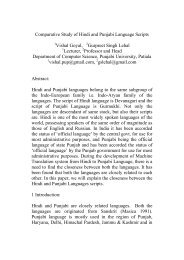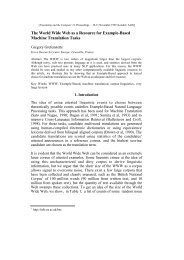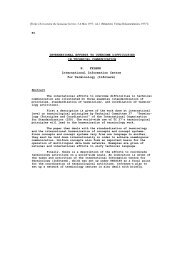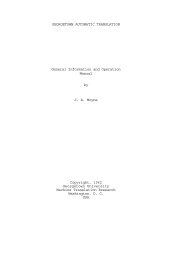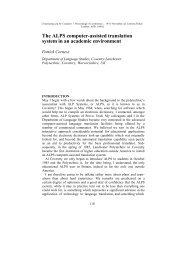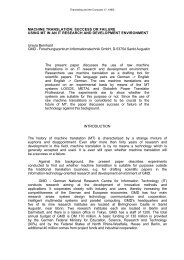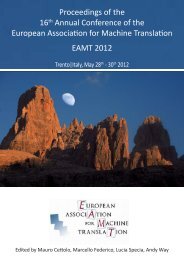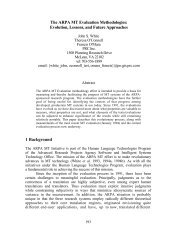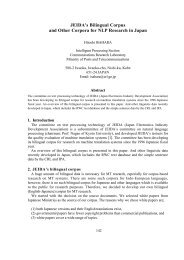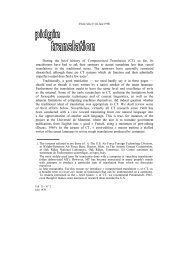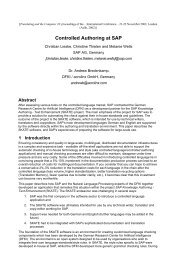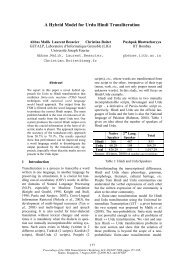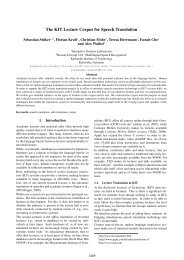Machine translation with inferred finite-state transducers
Machine translation with inferred finite-state transducers
Machine translation with inferred finite-state transducers
Create successful ePaper yourself
Turn your PDF publications into a flip-book with our unique Google optimized e-Paper software.
Computational Linguistics Volume 30, Number 2<br />
A stochastic <strong>finite</strong>-<strong>state</strong> transducer has stochastic source and target regular languages<br />
embedded (Pi and Po, respectively.):<br />
208<br />
Pi(s) = <br />
PTP (s, t), Po(t) = <br />
t∈∆ ⋆<br />
s∈Σ ⋆<br />
PTP (s, t)<br />
In practice, these source or target regular languages are obtained, by dropping the<br />
target or the source symbols, respectively, from each transition of the <strong>finite</strong>-<strong>state</strong> transducer.<br />
The following theorem naturally extends Theorem 1 to the stochastic framework<br />
(Casacuberta, Vidal, and Picó 2004):<br />
Theorem 2<br />
A distribution PT : Σ ⋆ × ∆ ⋆ → [0, 1] is a stochastic rational <strong>translation</strong> if and only if there<br />
exist an alphabet Γ, two morphisms hΣ : Γ ⋆ → Σ ⋆ and h∆ : Γ ⋆ → ∆ ⋆ , and a stochastic regular<br />
language PL such that, ∀(s, t) ∈ Σ ⋆ × ∆ ⋆ ,<br />
PT(s, t) = <br />
ω ∈ Γ ⋆ :<br />
(hΣ(ω), h∆(ω)) = (s, t)<br />
PL(ω) (5)<br />
3.1 Search <strong>with</strong> Stochastic Finite-State Transducers<br />
The search for an optimal ˆt in Equation (4) has proved to be a difficult computational<br />
problem (Casacuberta and de la Higuera 2000). In practice, an approximate solution<br />
can be obtained (Casacuberta 2000) on the basis of the following approximation to the<br />
probability of a <strong>translation</strong> pair (Viterbi score of a <strong>translation</strong>):<br />
PTP (s, t) ≈ VTP (s, t) = max PTP (φ) (6)<br />
φ∈d(s,t)<br />
An approximate <strong>translation</strong> can now be computed as<br />
˜t = argmax<br />
t∈∆⋆ VTP<br />
(s, t) =argmax<br />
t∈∆ ⋆<br />
max<br />
φ∈d(s,t)<br />
PTP (φ) (7)<br />
This computation can be carried out efficiently (Casacuberta 1996) by solving the<br />
following recurrence by means of dynamic programming:<br />
<br />
max VTP (s, t) = max V(|s|, q) · f (q) (8)<br />
t∈∆∗ q∈Q<br />
V(i, q) = max<br />
q ′ ∈Q,w∈∆ ⋆<br />
V(i − 1, q ′ ) · p(q ′ , si, w, q) <br />
if i = 0, q = q0<br />
V(0, q0) = 1 (10)<br />
Finally, the approximate <strong>translation</strong> ˜t is obtained as the concatenation of the target<br />
strings associated <strong>with</strong> the <strong>translation</strong> form<br />
˜φ =(q0,s1,¯t1, q1)(q1,s2,¯t2, q2) ...(qI−1,sI−1,¯tI, qI),<br />
corresponding to the optimal sequence of <strong>state</strong>s involved in the solution to Equation<br />
(8); that is,<br />
˜t = ¯t1 ¯t2 ...¯tI<br />
(9)



